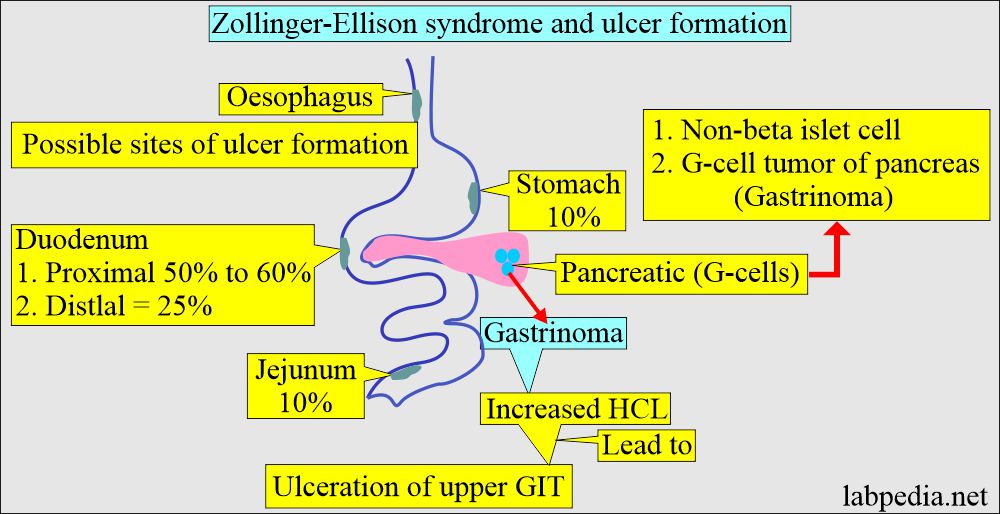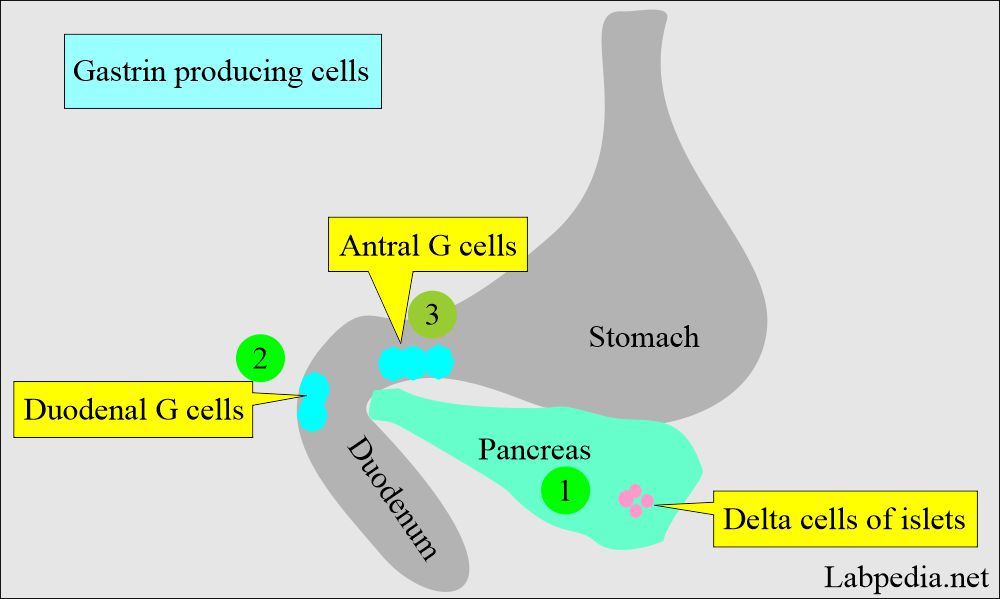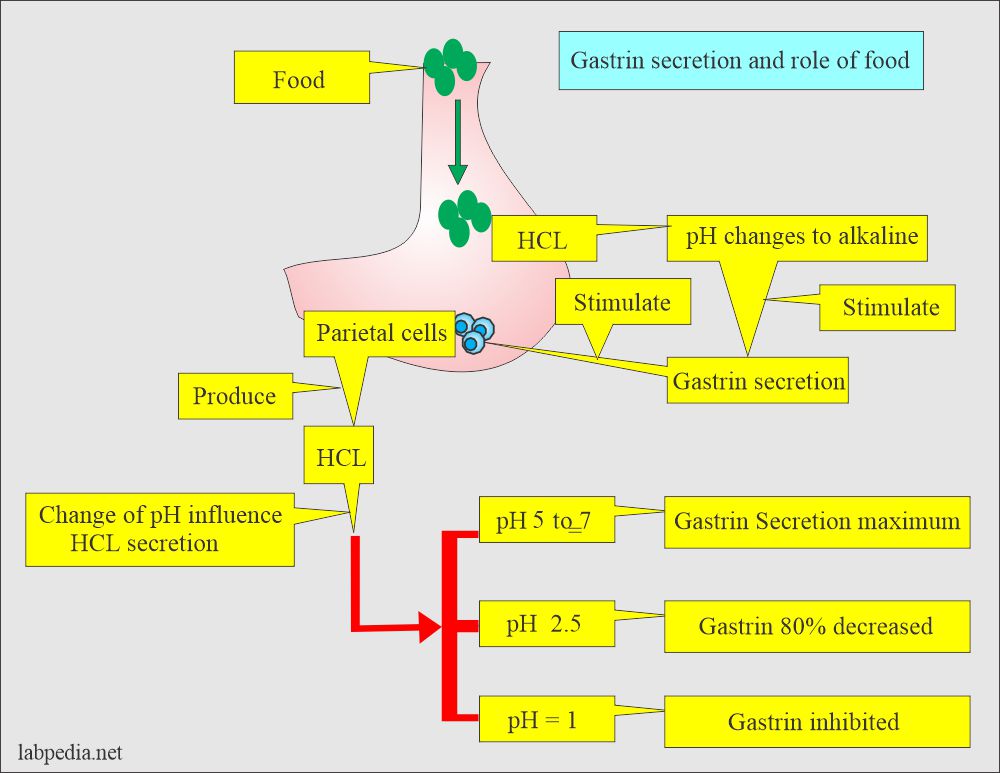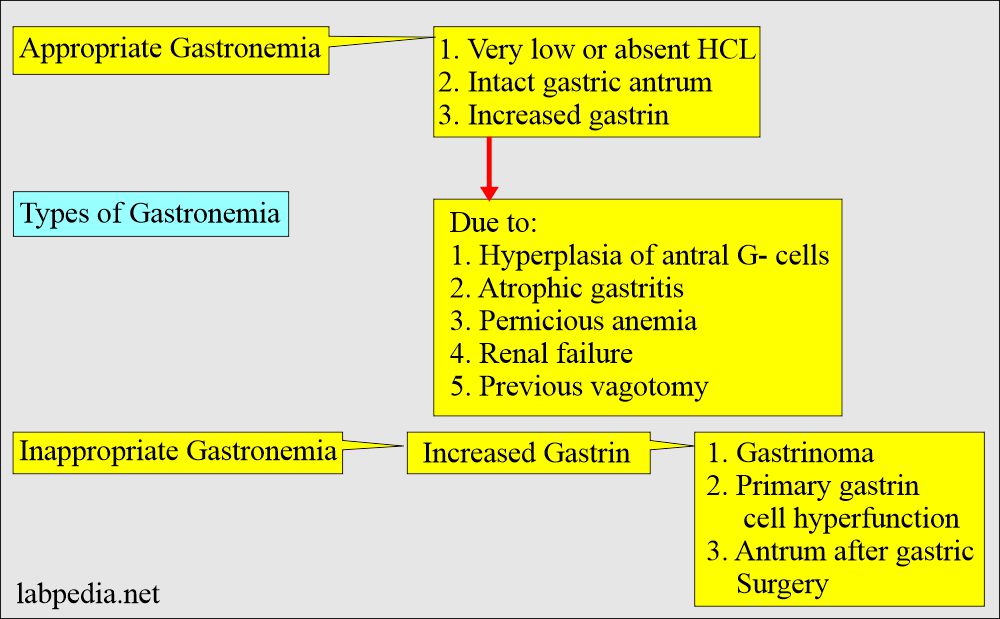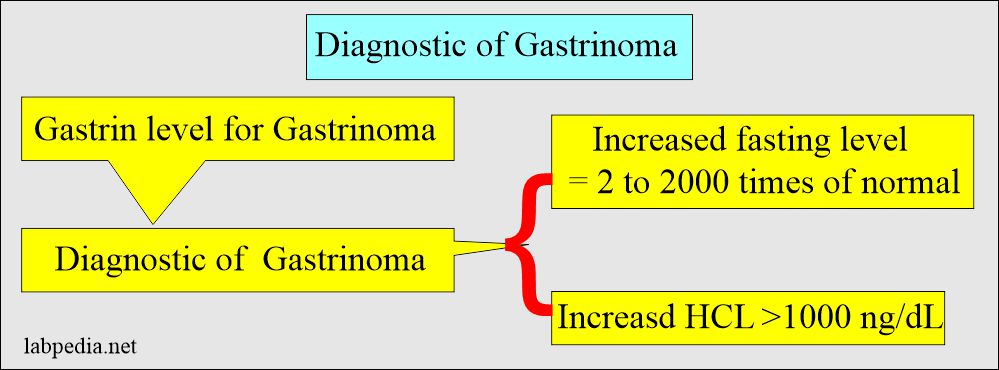Zollinger-Ellison Syndrome, Gastrinoma
Zollinger-Ellison Syndrome
What sample is needed for Zollinger-Ellison Syndrome?
- Gastrin is unstable in the serum, even on refrigeration.
- A fasting sample is preferred.
- Separate the serum immediately and freeze it.
- It can be stored at – 70 °C for a longer period.
What is the history of Zollinger-Ellison Syndrom?
- Zollinger and Ellison first noticed pancreatic islet cell lesions with gastric acid hypersecretion.
- They noticed severe peptic ulceration.
- Ulcers are present in 90% to 95% of patients.
- The ratio of duodenal to gastric ulcer is 6:1.
How will you define Zollinger-Ellison syndrome?
- Zollinger-Ellison syndrome is due to gastrin-secreting tumors called Gastrinomas, which may be duodenal or pancreatic endocrine tumors.
- Zollinger-Ellison syndrome:
- Gastrin-producing islet cell tumors cause gastric-acid hypersecretion with the formation of peptic ulcers and diarrhea.
- Gastrin level is >600 pg/mL, suggesting Gastrinoma.
- Non-beta cells of the pancreatic tumor produce a large amount of gastrin, and patients suffer from ulcers.
- Gastrin level is highly increased.
- Gastrin leads to increased production of acid, and there is a high level of HCL, which leads to multiple ulcers in the stomach and small bowel.
- Gastrinoma may arise in the pancreas, peripancreatic region, or duodenum wall.
How will you discuss the pathophysiology of Zollinger-Ellison Syndrome?
- Gastrin is a potent hormone secreted from gastric G cells, Proximal duodenal G cells, and pancreatic delta cells.
- This is under the control of vagal stimulation.
- Gastrin has three molecular forms:
- Big gastrin consists of 34 amino acids, G -34.
- Little gastrin consists of 17 amino acids, G -17.
- Minigastrin consists of 14 amino acids, G -14.
- Pentagastrin is a synthetic derivative used for gastric function testing to see the production of HCL.
- Differential diagnosis of Gastrinoma can be made by giving stimulating agents like:
- Secretin infusion.
- Calcium infusion.
- Standard meal.
What is the mechanism for Gastrin production?
- These are the sources of Gastrin secretion:
- Endocrine cells (G cells) of the antral mucosa of the stomach.
- The lesser amount of the G cells of proximal duodenum.
- A small amount from delta cells in the pancreas.
- After absorption into the blood, Gastrin goes to the liver and stimulates the parietal cell of the stomach to produce HCL.
- Gastrin is a very strong gastric acid secretion stimulant.
- It is more potent than histamine.
- Gastrin’s main role is to increase HCL secretion.
What are the inhibitory factors for gastrin secretion?
- High gastric acidity.
- The gastric inhibitory polypeptide is produced by the K cells of the intestinal mucosa (middle and distal duodenum and proximal jejunum in response to foods like fats, glucose, and amino acids.
- The vasoactive intestinal polypeptide is produced by the H cells of the intestinal mucosa.
- Gastrin is a weaker stimulant of pepsinogen + intrinsic factor.
What are the stimulants for Gastrin secretion?
- Antral distension.
- Meals.
- Partially digested food (Proteins).
- Free amino acids also stimulate gastrin.
- Carbohydrates and Fats have little effect on gastrin secretion.
- Other gastrin-release stimulants are:
- Alcohol.
- Caffeine.
- Insulin-induced hypoglycemia.
- Calcium ingestion or I/V infusion.
- Vagal stimulation by:
- Smell.
- Tasting.
- Swallowing.
- Chewing.
- Increased fasting gastrin level is associated with increasing age over 60 years.
- Secretion of gastrin depends upon the pH of gastric acid (HCl):
- pH 5 to 7 = Gastrin secretion is maximum.
- pH 2.5 = Gastrin secretion is reduced by 80%.
- pH 1.0 = Maximum suppression of Gastrin production.
What are the important facts about Gastrinoma?
- Gastrinomas arise in the pancreas and or the wall of the duodenum.
- More than 50% of tumors are invasive and have already metastasized.
- Around 25% of the patients with gastrinoma have multiple tumors as a part of a condition called multiple endocrine neoplasia type 1 (MEN 1).
- MEN 1 has tumors in the pituitary gland and parathyroid gland, in addition to the cancer of the pancreas.
What is the clinical Presentation of Zollinger-Ellison Syndrome?
- Zollinger-Ellison syndrome is divided into two types:
- Type 1 is called G-cell hyperplasia without the presence of Gastrinoma.
- Type II is due to the gastrinoma of the pancreas or duodenum.
- Patients with Zollinger–Ellison syndrome may experience abdominal pain and chronic diarrhea, including steatorrhea (fatty stools).
- Zollinger syndrome is suspected by:
- Clinical history.
- Radiological evidence of ulceration.
- Excessive acid secretion.
- Zollinger syndrome is suspected by:
- These patients have severe ulceration of the stomach and small bowel, especially if they fail to respond to treatment.
- The ulcers are present in 90% to 95%.
- The ratio of duodenal to stomach ulcers is 6:1.
- Other signs and symptoms are:
- Esophageal chest pain.
- Pain in the esophagus, especially between and after meals at night.
- Nausea.
- Wheezing.
- Hematemesis (digested blood).
- Malnourishment.
- Loss of weight due to loss of appetite.
- There is chronic diarrhea with variable severity and accompanied by hypokalemia.
- >50% of the patients have diarrhea, and 30% have the presenting symptoms.
What is the normal Gastrin level?
Source 1
| Age | pg/mL |
| Cord blood | 20 to 290 |
| 0 to 4 days | 120 to 183 |
| Child | <10 to 125 |
| Adult | |
| 60 to 90 years | 25 to 90 |
| >60 years | <100 |
- To convert into Si units x 1.0 = ng/L
Source 2
- 0 to 180 pg/mL
- Levels are higher in old people.
Other sources
- Fasting level-up to 100 ng/L.
- Older people over 60 years = 100 to 800 ng/L.
- Adult = 0 to 180 ng/L.
- Child = 0 to 125 ng/L.
- The level fluctuates during the day:
- Highest during the daytime.
- Highest after the meal.
- The lowest level is from 3.00 to 7.00 am.
- Highest during the daytime.
How will you diagnose Gastrinoma?
- Raised level of Gastrin (Hypergastrinemia).
- Fasting gastrin level is markedly raised from 2 to 2000 times normal.
- A gastrin level of 1000 ng/L is diagnostic.
- The fasting gastrin level is raised in >95% of the cases.
- Mostly, it is >1000 pg/mL (1000 ng/L), and these values are used to diagnose gastrinoma.
How will you summarize the Diagnosis of Zollinger-Ellison syndrome?
| Clinical condition | Serum gastrin level |
|
|
|
|
|
|
|
|
How will you manage Zollinger-Ellison Syndrome?
- Surgical removal of the tumor.
- Medical management: Proton pump inhibitors to reduce acid secretion.
- Totally resected tumors have a good prognosis, and the syndrome may disappear.
- Patients with liver metastasis have a poor prognosis.
Questions and answers:
Question 1: What is the value of gastrin diagnostic of gastrinoma?
Question 2: What will be the gastrin level in pernicious anemia?

